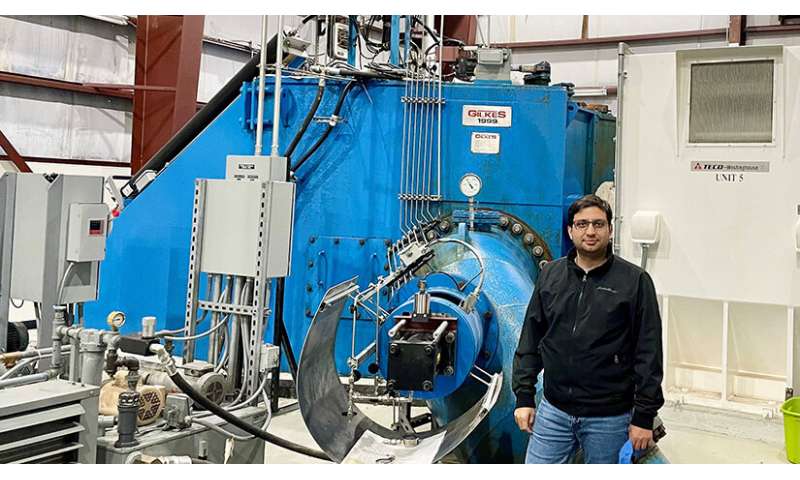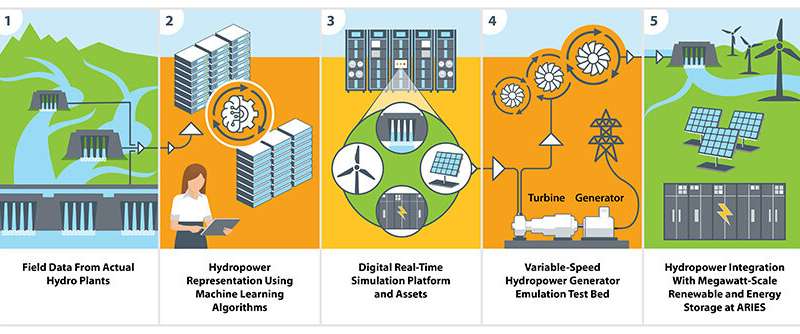New hydropower emulation platform offers low-cost, low-risk evaluation of new technology designs

Consider two hydropower scenarios: First, a severe winter storm hits the Midwest. Power outages ricochet across the region, stranding residents in freezing temperatures for hours; and yet, the area's hydropower plants could jump-start the grid if only they had the right system to do so.
The second takes place in the remote Alaskan city of Cordova, which can run its local grid on hydropower alone—or it can in the summer, at least. Once winter blows in, water stays frozen, and avalanches can rumble through, cutting off power when temperatures are at their lowest.
Both of these scenarios are real examples of where hydropower could—but cannot quite—fulfill its role as the reliable backbone of our power grids. As the United States adds more and more renewable energy to the power grid, hydropower's steady, affordable energy is key to making the grid both dependable and resilient. But today's plants could be even better—and more flexible—if researchers can find a better way to study these big, complex facilities.
Now, experts at the National Renewable Energy Laboratory (NREL) have designed a way to do exactly that. With their Real-Time Hydropower Emulation Platform, which uses field data from actual hydropower plants, mathematical models, and even hardware, researchers can recreate hydropower plants in a virtual, lab setting. With the platform, users can study how various hydropower plant designs are likely to operate in the real world and in real time—providing a low-cost, low-risk way to test out new hydropower technologies and grid configurations.
"We want the field to come to the lab," said Mayank Panwar, the lead researcher on the three-year project, which is funded by the U.S. Department of Energy's Water Power Technologies Office (WPTO) as part of its Water Innovation for a Resilient Electricity System (HydroWIRES) Initiative.
Panwar's hydropower emulation platform first got started thanks to the WPTO Seedlings and Saplings program, which supports creative, high-risk, high-reward ideas in water power. With this initial investment, Panwar and his team set out to solve a big challenge that can hinder the hydropower industry from adopting new technologies and designs: How do you test something you cannot build?
Researchers can build a new solar photovoltaic system to validate in the field. But building a hydroelectric prototype is often impractical, time consuming, and expensive because these plants are so large and depend on specific geographies—sometimes whole mountains—to operate. And tinkering with operational facilities is risky; tests could cause irreversible damage.
Even so, new hydropower technologies and grid configurations are perhaps more critical today than ever before. As the United States transitions to a 100% clean energy power grid, hydropower's flexible, reliable energy—and energy storage—will play a big role in keeping that grid running smoothly. And while researchers have studied how solar power and wind energy technologies integrate into the grid, how hydropower could support a future clean energy grid is not as well understood.

"It's a significant addition to our emulation platform" said Rob Hovsapian, a senior research advisor at NREL, who helped build the emulation platform. "Hydropower needs to live with the changing grid, and we want to make it a better resource in terms of flexibility and reliability."
To provide that flexible, reliable energy, the hydropower industry is using more power electronics, which give them finer control over their plants' energy output. Greater control means plants can quickly respond to cyber and natural threats, like the severe winter storm that knocked out power in the Midwest.
"Hydropower plants need to essentially reinvent the way they're operated and controlled," Panwar said.
In the initial Seedlings project, Panwar and his colleagues collected field data from hydropower plants operating in the remote Alaskan city of Cordova. Then, using machine learning, they designed software representations that could realistically imitate a hydropower plant, including its electronic controls, turbines, hydraulic and mechanical circuits, and even water flows—all in real time. "If a phenomenon that happens in your system takes 10 seconds in the real world, then the computation of this system also produces the solution by the wall clock time," Panwar said.
But how do you realistically imitate a real-life grid? To learn how these new hydropower designs might integrate into various grid systems, Panwar and his team turned to NREL's Advanced Research on Integrated Energy Systems (ARIES). With ARIES, one of the U.S. Department of Energy's largest digital grid simulation platforms, the hydro emulation platform could mimic how hydropower plants might pair up with energy storage and other renewable energy technologies to provide more reliable energy to a grid.
ARIES also provides an opportunity to connect the team's software to actual hardware, like rotating machines that represent a hydropower plant's rotating turbine, to get as close as possible to replicating a real-life plant in the safety of a controlled lab environment.
Next, Panwar and his team plan to scale up their emulation platform to mimic plants that can generate megawatts of energy (right now the platform is capped at 2.5 megawatts). Along the way, they will continue to check in with their industry advisory board to learn what challenges hydropower plants are facing and how the hydropower emulation platform could help. Eventually, Panwar hopes the industry sees his platform as their go-to test bed.
If Panwar gets his wish, hydro-rich utilities across the United States, could quickly learn how to reconfigure their local hydropower plants and grid to better serve their customers—keeping the heat and lights on even during severe winter storms and well into a 100% clean energy future.
Provided by National Renewable Energy Laboratory